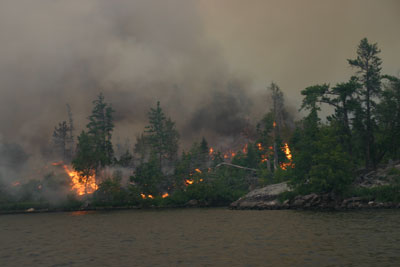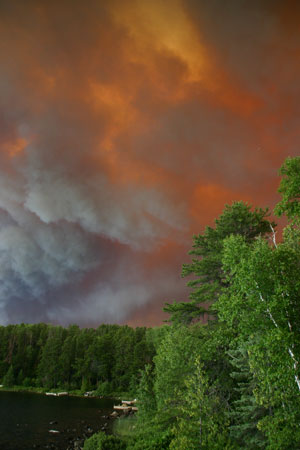| Cavity
Lake Fire, MN |
Lee
E. Frelich |
| Jul
20, 2006 09:43 PDT |
ENTS:

Seagull Lake Island Fire - photo by Carol DeSain
http://www.boreal.org/fireinfo/Cavity_Lake_Fire/photo_gallery.html
The Cavity Lake wildfire in the Boundary Waters was ignited by a
lightning
strike last Friday and has burned 22,000 acres of boreal forest
of jack
pine, black spruce, balsam fir, white and red pine, white cedar,
and paper
birch. It made a major run during a period of high winds on
Saturday and
Sunday, which was when most of the acreage burned. Much of the
forest in
the area was affected by the big blowdown of 1999, so there is
50-100 tons
of dry fuel per acre. Flame lengths have been up to 100 feet.
Some people
who live on the Gunflint Trail at the edge of the wilderness
have evacuated
to escape the smoke, but official evacuations have not been
ordered yet.
The fire will probably continue to burn until a major rainfall
occurs.
Nearly all of the 700+ plots established by my graduate student
Roy Rich to
follow regeneration in the blowdown have burned. He was there
surveying
plots when the fire made its big run on Saturday and Sunday, and
took a lot
of spectacular photos while retreating from the Seagull Lake
area. The
fire crossed Seagull Lake, which is 6 miles long, by jumping
from island to
island. Some of the islands burned, including Miles Island, had
a white and
red pine forest that originated after a burn in 1692, and groves
of ancient
cedars several hundred years old. It will be a while before the
area is
open and we can get in to see how many of the old trees
survived.
Our study of standing old growth forests begun in 1992, became a
study of
blowdown in 1999, then a study of blowdown with prescribed
burns, and now
blowdown followed by wildlfire. The study design keeps changing
as an
endless parade of big disturbances unfold.
You can see the perimeter map, description of the fire, and
photos at the
Minnesota Incident Command System website http://www.mnics.org
. Click
on the
first red button (current fire info), and then on Cavity Lake
Fire.
Lee
|
| Re:
Cavity Lake Fire |
Lee
E. Frelich |
| Jul
21, 2006 12:07 PDT |
ENTS:
If you go to the Minnesota Incident Command System website
http://www.mnics.org,
and look at the photos for the Cavity Lake fire, photos
16.jpg-20.jpg were
taken by our field crew from the University of MN. The guy in
the yellow
shirt in 17.jpg is Roy Rich, my former Ph.D. student, who is now
a post-doc
who will be collecting data from our 700 plots when the fire is
over.

Smoke over Seagull Lake - photo by Carol De Sain
http://www.boreal.org/fireinfo/Cavity_Lake_Fire/photo_gallery.html
There are also a lot of photos at this gallery:
http://www.boreal.org/fireinfo/Cavity_Lake_Fire/photo_gallery.html
Some of the
pictures show the lake in whitecaps heading towards the fire,
since the fire was sucking air in at high speeds when it blew
up.
Within a few days, The University of Minnesota will be posting
all of our
photos along with some videos taken by our crew as they
retreated from the
field sites ahead of the flames.
I have been on numerous radio stations throughout the day today
talking
about the fire, I did an hour long live call in show this
morning, and now
I am starting to prepare for tonight's live television
appearance on the
Twin Cities Public Television Almanac newsmagazine.
Lee
|
| Re:
Cavity Lake Fire |
Lee
Frelich |
| Jul
23, 2006 09:11 PDT |
Jess:
The fire is now 33,000 acres. That is about half the size of the
fires of
1692 and 1801 that burned the same area around Seagull Lake. The
fires of
1865 burned over 400,000 acres within the BWCAW (the figure you
cite of
180,000 must be hectares).
I don't think the size of this fire has been affected by fire
management
during the 20th century, although its impact on the forest might
be
different. It was ignited just before the high winds occurred,
so I don't
think it could have been suppressed. Fire suppression generally
has little
impact in the boreal forest. There has been light rain in the
area this
morning, and larger thunderstorms are possible this afternoon,
but it would
take 2 inches of rain to put out the fire. The fire will be with
us until
a 'season ending event', whether that's a period of heavy rain
now or snow
in October.
Bob is planning to visit next summer--and now I will have
spectacular
burned sites to visit and contrast to the remaining old growth.
No doubt we
will get some major studies underway. This is the first large
fire in
northern MN comparable in scale to the great historical fires,
and it will
be the subject of modern research techniques.
I have been on dozens of radio shows talking about the fire, I
did a live
hour-long call in show on public radio Friday morning, and
appeared on a
live TV show during Friday prime time. Live TV and radio are
fun--time
continues to go by whether you make any mistakes or not. The
hours of
retakes necessary for pretaped shows are an intense, exhausting,
and
extreme hassle. So far I have managed to avoid pretaped shows
about the
fire. Fortunately, I have a manager at the University News
Service who
manages and schedules my media appearances for me. I no longer
have to deal
with reporters, I just get a schedule of each day's media
appearances from
the University News Service. Monday and Tuesday are already
booked.
Lee
At 02:32 PM 7/22/2006, you wrote:
| |
Hello
Lee,
Thanks for passing along the information on the fire.
The 22,000
acres sounds pretty large for one after the early
1900's, but still
relative small compared to some earlier fires. Were the
largest
recorded fires in the Boundary Waters around 180,000
areas (or was
that hectares)? Have changes in fire management allowed
this fire to
become larger than it would have a few decades ago? It
sounds like it
could have been suppressed before the windy days, but
would now take a
major effort to slow down.
Jess
|
|
| Cavity
Lake Fire, MN |
Lee
E. Frelich |
| Jul
27, 2006 09:52 PDT |
ENTS:
The fire has created 50 square miles of new forest, and its
growth has
slowed dramatically after 0.5 inches of rain fell a few days
ago. Currently
it is listed as 45% contained. There is some concern that parts
of the
fire might flare up again as another heat wave moves in, with
temperatures
near 100 in Minneapolis and in the upper 80s in northern MN from
tomorrow
through Monday.
The University of MN Department of Forest Resources website now
has 18
pictures posted taken by our field crew as they were chased out
of the
wilderness by the fire. You can also listen to a call in show I
did on
public radio at the website:
http://fr.cfans.umn.edu/
Lee |
| Minnesota
old-growth forests: dead and alive - the
Cavity Lake Fire |
Lee
E. Frelich |
| Aug
29, 2006 08:01 PDT |
ENTS:
...
At the other
end of Minnesota, unfortunately the Cavity Lake Fire killed
much of the 310 year old stand of red and white pine on Mile's
Island in
Seagull Lake. A few small patches remain alive, probably enough
to reseed
the rest of the island and perpetuate the genetic heritage of
this 5000
year old population. The 200-400 year pine stands on the south
half of
ThreeMile Island and around the southwest half of Seagull Lake
were
completely exterminated. The ancient cedars of Seagull Lake
survived in
some areas, but I have reports that some of the 500-1000 year
old trees
were killed by the fire.
Lee
|
|